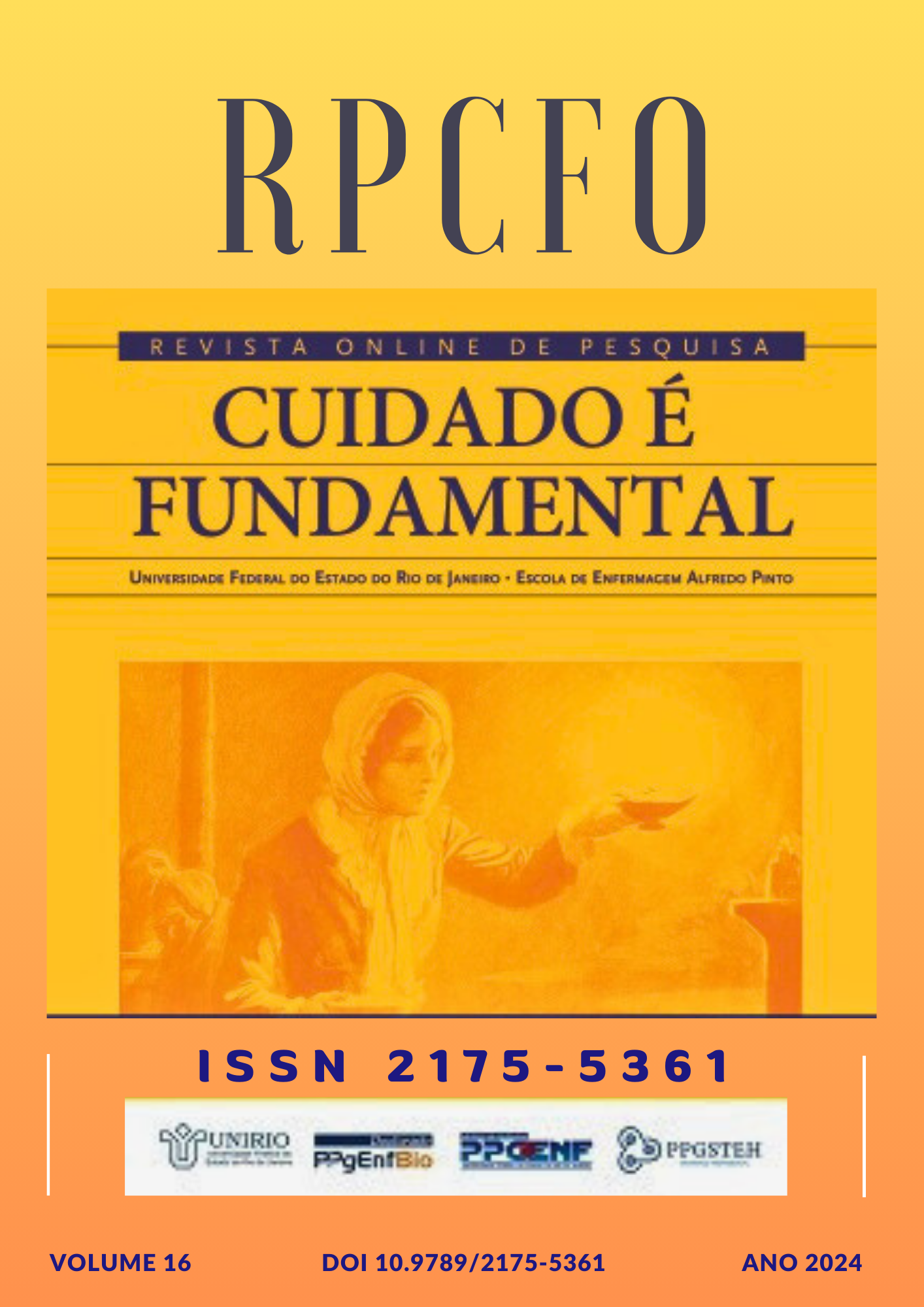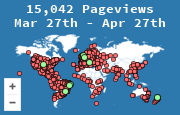Key populations for human immunodeficiency virus in nursing studies: an integrative review / Populações-chave ao vírus da imunodeficiência humana nos estudos da enfermagem: revisão integrativa
an integrative review
DOI:
https://doi.org/10.9789/2175-5361.rpcfo.v16.12987Palavras-chave:
Populações Vulneráveis, Vulnerabilidade Social, HIV, Síndrome de Imunodeficiência Adquirida, EnfermagemResumo
Objetivo: evidenciar as populações-chave ao vírus da imunodeficiência humana abordadas em estudos científicos de enfermagem. Método: revisão integrativa da literatura realizada nas bibliotecas National Library of Medicine, National Institutes of Health, Scientific Electronic Library Online e Biblioteca Virtual de Saúde; nas bases de dados Embase, Cummulative Index to Nursing and Allied Health Literature, Scopus, Web of Science e Literatura Latino-Americana e do Caribe em Ciências da Saúde. Resultados: identificados 1.059 artigos, dos quais 18 foram incluídos. Os achados foram agrupados conforme as dimensões da vulnerabilidade (individual, social e programática). Conclusão: o papel da enfermagem diante das dimensões individuais, sociais e programáticas da vulnerabilidade, foi importante para identificar as especificidades dessas populações e para a compreensão dos aspectos que tornam estes indivíduos vulnerabilizados ao HIV/aids. Verifica-se a intervenção direta da enfermagem por meio de ações de promoção e prevenção de modo a contribuir para as boas práticas de cuidado.
Downloads
Referências
Hahn RA. What is a social determinant of health? Back to basics. J Public Health Res. [Internet]. 2021 [cited 2023 oct 10];10(4). Available from: https://doi.org/10.4081/jphr.2021.2324.
Smallheer B. Addressing and dismantling inequities of vulnerable populations. Nurs Clin North Am. [Internet]. 2022 [cited 2023 oct 10];57(3). Available from: https://doi.org/10.1016/j.cnur.2022.07.001.
Ayres JR. Vulnerabilidade, Cuidado e integralidade: reconstruções conceituais e desafios atuais para as políticas e práticas de cuidado em HIV/Aids. Saúde debate [Internet]. 2022 [acesso em 10 de outubro 2023];46(spe7). Available from: https://doi.org/10.1590/0103-11042022E714.
Fernandes BA, Rodrigues RAP, Tavares DMS, Haas VJ. Factors associated with the social, individual and programmatic vulnerability of older adults living at home. Rev Esc Enferm USP. [Internet]. 2019 [cited 2023 oct 10];53. Available from: https://doi.org/10.1590/S1980-220X2017050103429.
Silva AFCD, Cueto M. HIV/AIDS, its stigma and history. Hist ciênc saúde-Manguinhos. [Internet]. 2018 [cited 2023 oct 10];25(2). Available from: https://doi.org/10.1590/S0104-59702018000200001.
Castellanos MEP, Baptista TWF, Ayres JR. Interview with José Ricardo Ayres. Saúde Soc. [Internet]. 2018 [cited 2023 oct 10];27(1). Available from: http://dx.doi.org/10.1590/s0104-12902018000002.
The Joint United Nations Programme on HIV/AIDS (UNAIDS). Fact Sheet 2022 [Internet]. 2022 [cited 2023 oct 10]. Available from: https://unaids.org.br/wp-content/uploads/2022/07/2022_07_27_Factsheet_PT.pdf.
Ministério da Saúde (BR). Boletim Epidemiológico - HIV/Aids 2022 [Internet]. 2022 [acesso em 10 de outubro 2023]. Disponível Em: https://www.gov.br/aids/pt-br/centrais-de-conteudo/boletins-epidemiologicos/2022/hiv-aids.
Silva AR, Padilha MI, Petry S, Silva VS, Woo K, Galica J, et al. Reviews of literature in nursing research methodological considerations and defining characteristics. ANS Adv Nurs Sci. [Internet]. 2022 [cited 2023 oct 10];45(3). Available from: https://doi.org/10.1097/ANS.0000000000000418.
Tricco A, Lillie E, Zarin W, O’brien KK, Colquhoun H, Levac D, et al. PRISMA Extension for Scoping Reviews (PRISMA-ScR): Checklist and Explanation. Ann Intern Med. [Internet]. 2018 [cited 2023 oct 10];169(7). Available from: https://doi.org/10.7326/M18-0850.
Aromataris E, Munn Z. JBI Manual for Evidence Synthesis. JBI [Internet]. 2020 [cited 2023 oct 10]. Available from: https://synthesismanual.jbi.global. https://doi.org/10.46658/JBIMES-20-01
Noyes J, Booth A, Moore G, Flemming K, Tunçalp Ö, Shakibazadeh E. Synthesising quantitative and quali-tative evidence to inform guidelines on complex interventions: Clarifying the purposes, designs and outlining some methods. BMJ Glob Health. [Internet]. 2019 [cited 2023 oct 10];4(suppl 1). Available from: http://dx.doi.org/10.1136/bmjgh-2018-000893.
Hong QN, Pluye P, Fàbregues S, Bartlett G, Boardman F, Cargo M, et al. Improving the content validity of the mixed methods appraisal tool: A modified e-Delphi study. J Clin Epidemiol. [Internet]. 2019 [cited 2023 oct 10];111. Available from: https://doi.org/10.1016/j.jclinepi.2019.03.008.
Brito DMS, Galvão MTG, Pereira MLD. Markers of vulnerability for cervical cancer in HIV-infected women. Rev latinoam enferm. [Internet]. 2011 [cited 2023 oct 10];19(3). Available from: https://doi.org/10.1590/S0104-11692011000300008.
Alencar RA, Ciosak SI. Late diagnosis and vulnerabilities of the elderly living with HIV/AIDS. Rev Esc Enferm USP. [Internet]. 2015 [cited 2023 oct 10];49(2). Available from: https://doi.org/10.1590/S0080-623420150000200007.
Bezerra VP, Serra MAP, Cabral IPP, Moreira MASP, Almeida AS, Patrício ACFA. Preventive practices in the elderly and vulnerability to HIV. Rev gaúch enferm. [Internet]. 2015 [cited 2023 oct 10];36(4). Available from: https://doi.org/10.1590/1983-1447.2015.04.44787.
Lambret LCR, Silva RJC. Prevalence and types of rectal douches used for anal intercourse among men who have sex with men in Brazil. BMJ Open. [Internet]. 2017 [cited 2023 oct 10];7(5). Available from: https://doi.org/10.1136/bmjopen-2016-011122.
Guimarães RA, Monteiro LHB, Teles AS, Fernandes IL, Rodovalho AG, Silva GC, et al. Risk behaviors for sexually transmitted infections in noninjecting drug users: A cross-sectional study. Int J STD AIDS. [Internet]. 2018 [cited 2023 oct 10];29(7). Available from: https://doi.org/10.1177/0956462417750332.
Costa MIF, Rodrigues RR, Teixeira RM, Paula PHA, Luna IT, Pinheiro PNC. Adolescents in situations of poverty: resilience and vulnerabilities to sexually transmitted infections. Rev bras enferm. [Internet]. 2020 [cited 2023 oct 10];73(suppl4). Available from: https://doi.org/10.1590/0034-7167-2019-0242.
Scarinci IC, Ribeiro M, Gibson E, Hansen B, Kienen N. Assessing tobacco cessation needs among persons living with HIV in Brazil: results from a qualitative interview study. J Assoc Nurses AIDS Care. [Internet]. 2021 [cited 2023 oct 10];32(2). Available from: https://doi.org/10.1097/JNC.0000000000000181.
Vernaglia TVC, Leite TH, Faller S, Pechansky F, Kessler FHP, Cruz MS, et al. The female crack users: Higher rates of social vulnerability in Brazil. Health Care Women Int. [Internet]. 2017 [cited 2023 oct 10];38(11). Available from: https://doi.org/10.1080/07399332.2017.1367001.
Amorim TF, Teles SA, Moraes LC, Matos MA, Carneiro MAS, Nogueira DJ, et al. Symptomatic sexually transmitted infections in Brazil emerging rural populations. J Assoc Nurses AIDS Care. [Internet]. 2018 [cited 2023 oct 10];29(6). Available from: https://doi.org/10.1016/j.jana.2018.05.004.
Melo GC, Oliveira ECA, Leal IB, Silva CPMFS, Beltrão RA, Santos AD, et al. Spatial and temporal analysis of the human immunodeficiency virus in an area of social vulnerability in Northeast Brazil. Geospat Health. [Internet]. 2020 [cited 2023 oct 10];15(2). Available from: https://doi.org/10.4081/gh.2020.863.
Soares JP, Teles SA, Caetano KAA, Amorim TF, Freire MEM, Nogueira JA, et al. Factors associated with sexually transmitted infections in sugarcane cutters: subsidies to caring for. Rev latinoam enferm. [Internet]. 2020 [cited 2023 oct 10];28. Available from: https://doi.org/10.1590/1518-8345.3425.3306.
Holanda ER, Galvão MTG, Pedrosa NL, Paiva SS, Almeida RLF. Spatial analysis of infection by the human immunodeficiency virus among pregnant women. Rev latinoam enferm. [Internet]. 2015 [cited 2023 oct 10];23(3). Available from: https://doi.org/10.1590/0104-1169.0481.2574.
Silva IR, Gomes AMT, Valadares GV, Santos NLP, Silva TP, Leite JL. Nurses’ perceptions of the vulnerabilities to STD/AIDS in light of the process of adolescence. Rev gaúch enferm. [Internet]. 2015 [cited 2023 oct 10];36(3). Available from: https://doi.org/10.1590/1983-1447.2015.03.47293.
Alencar RA, Ciosak SI. Aids in the elderly: reasons that lead to late diagnosis. Rev Bras Enferm. [Internet]. 2016 [cited 2023 oct 10];69(6). Available from: https://doi.org/10.1590/0034-7167-2016-0370
Santos MCF, Nóbrega MML, Silva AO, Bittencourt GKGD. Nursing diagnoses for elderly women vulnerable to HIV/AIDS. Rev Bras Enferm. [Internet]. 2018 [cited 2023 oct 10];71(suppl3). Available from: https://doi.org/10.1590/0034-7167-2017-0086.
Lopes LM, Andrade RLP, Arakawa T, Magnabosco GT, Nemes MIB, Netto AR, et al. Vulnerability factors associated with HIV/AIDS hospitalizations: a case-control study. Rev Bras Enferm. [Internet]. 2020 [cited 2023 oct 10];73(3). Available from: https://doi.org/10.1590/0034-7167-2018-0979.
Pimenta MC, Bermúdez XP, Godoi AMM, Maksud I, Benedetti M, Kauss B, et al. Barriers and facilitators for access to PrEP by vulnerable populations in Brazil: the ImPrEP Stakeholders Study. Cad Saúde Pública. [Internet]. 2022 [cited 2023 oct 10];38(1). Available from: https://doi.org/10.1590/0102-311X00290620.
Santos GM, Hong C, Wilson N, Nutor JJ, Harris O, Garner A, et al. Persistent disparities in COVID-19-associated impacts on HIV prevention and care among a global sample of sexual and gender minority individuals. Glob public health. [Internet]. 2022 [cited 2023 oct 10];17(6). Available from: https://doi.org/10.1080/17441692.2022.2063362.
Brito ES, Knauth DR, Brand ÉM, Calvo KDS, Vigo Á, Pilecco FB, et al. Factors associated with HIV and vulnerability contexts for women in Brazil. Arch Sex Behav. [Internet]. 2021 [cited 2023 oct 10];50(7). Available from: https://doi.org/10.1007/s10508-021-01960-7.
Zachek CM, Coelho LE, Domingues RMSM, Clark JL, De Boni RB, Luz PM, et al. The intersection of HIV, social vulnerability, and reproductive health: analysis of women living with HIV in Rio de Janeiro, Brazil from 1996 to 2016. AIDS Behav. [Internet]. 2019 [cited 2023 oct 10];23(6). Available from: 10.1007/s10461-019-02395-x.
Silva CM, Alves RS, Santos TS, Bragagnollo GR, Tavares CM, Santos AAP. Epidemiological overview of HIV/AIDS in pregnant women from a state of northeastern Brazil. Rev Bras Enferm. [Internet]. 2018 [cited 2023 oct 10];71(suppl1). Available from: http://dx.doi.org/10.1590/0034-7167-2017-0495.
Silva JKB, Santos JM, Romero ROG, Nóbrega LMB, Queiroga RPF, Leadebal ODCP, et al. HIV infections in youth: prevalence and associated factors. Rev Rene. [Internet]. 2023 [cited 2023 oct 10];24. Available from: https://doi.org/10.15253/2175-6783.20232483018.
Souza SO, Paula AC, Silva CA, Carvalho PMRS, Souza MM, Matos MM. Gender inequalities and vulnerability to sti/hiv/aids in urban settlement adolescents: an exploratory study. Cienc enferm. [Internet]. 2020 [cited 2023 oct 10];26. Available from: http://dx.doi.org/10.29393/ce26-5igso60005.
Kpelly E, Schauder S, Bohm MK, Sounga D, Moukouta C. Profiles and health risks (STIs, HCV, HIV) of injecting drug users. Rev Epidemiol Sante Publique. [Internet]. 2022 [cited 2023 oct 10];70(6). Available from: http://dx.doi.org/10.1016/j.respe.2022.08.007.
Aguiar RB, Leal MCC, Marques APO, Torres KMS, Tavares MTDB. Elderly people living with HIV - behavior and knowledge about sexuality: an integrative review. Cien Saude Colet. [Internet]. 2020 [cited 2023 oct 10];25(2). Available from: https://doi.org/10.1590/1413-81232020252.12052018.
Flanagan BE, Hallisey EJ, Adams E, Lavery A. Measuring community vulnerability to natural and anthropogenic hazards: the centers for disease control and prevention’s social vulnerability index. J Environ Health [Internet]. 2018 [cited 2023 oct 10];80. Available from: https://www.ncbi.nlm.nih.gov/pmc/articles/PMC7179070/pdf/nihms-1063751.pdf
Costa AS, Almeida PF. Vulnerabilities and decentralization of operations for attention to HIV/AIDS for Primary Health Care. Northeast, Brazil, 2019. Rev Gerenc Polit Salud. [Internet]. 2021 [cited 2023 oct 10];20. Available from: https://doi.org/10.11144/Javeriana.rgps20.vdac.
Garnelo L, Lima JG, Rocha ESC, Herkrath FJ. Access and coverage of primary health care for rural and urban populations in the northern region of Brazil. Saúde debate. [Internet]. 2018 [cited 2023 oct 10];42(spe). Available from: https://doi.org/10.1590/0103-11042018S106.
Prabhu S, Wanje G, Oyaro B, Otieno F, Mandaliya K, Jaoko W, et al. Adaptation of a social vulnerability index for measuring social frailty among East African women. BMC Public Health. [Internet]. 2022 [cited 2023 oct 10];22. Available from: https://doi.org/10.1186/s12889-022-12597-z.
Shimizu HE, Trindade JS, Mesquita MS, Ramos MC. evaluation of the responsiveness index of the family health strategy in rural areas. Rev Esc Enferm USP. [Internet]. 2018 [cited 2023 oct 10];52. Available from: https://doi.org/10.1590/s1980-220x2017020203316.
Paz PdO, Silva N, Becker L, Rigatto R. vulnerability of women in situation of violence in specialized service. Aquichan. [Internet]. 2019 [cited 2023 oct 10];19(2). Available from: https://doi.org/10.5294/aqui.2019.19.2.2.
Kapadia F. Structural interventionsthat reduce HIV vulnerability: a public health ofconsequence, June 2022. Am J Public Health. [Internet]. 2022 [cited 2023 oct 10];112(6). Available from: https://doi.org/10.2105/AJPH.2022.306869.
Azevedo SGV, Florêncio RS, Cestari VRF, Silva MAM, Pessoa VLMP, Moreira TMM. Programmatic vulnerability in health: concept analysis. REME rev min enferm. [Internet]. 2022 [cited 2023 oct 10];26. Available from: https://doi.org/10.35699/2316-9389.2022.39021.
Morais TCA, Monteiro PS. Concepts of human vulnerability and individual integrity in bioethics. Rev bioét. [Internet]. 2017 [cited 2023 oct 10];25(2). Available from: http://dx.doi.org/10.1590/1983-80422017252191.
Publicado
Como Citar
Edição
Seção
Licença
Copyright (c) 2024 Revista de Pesquisa Cuidado é Fundamental Online

Este trabalho está licenciado sob uma licença Creative Commons Attribution-NonCommercial-ShareAlike 4.0 International License.
TERMO DE TRANSFERÊNCIA DE DIREITOS AUTORAIS
Transfiro os direitos autorais deste artigo para a Revista de Pesquisa Cuidado é Fundamental - Online - RPCF, assim que ele for aceito para a devida publicação eletrônica. Os direitos de autor incluem o direito de reproduzir na íntegra ou em parte por qualquer meio, distribuir o referido artigo, incluindo figuras, fotografias, bem como as eventuais traduções. O autor pode ainda, imprimir e distribuir cópias do seu artigo, desde que mencione que os direitos pertencem a RPCF. Declaro que este manuscrito é original, não tendo sido submetido à publicação, na íntegra ou em partes para outros periódicos online ou não, assim cmmo em Anais de eventos científicos ou capítulos de livros.






























